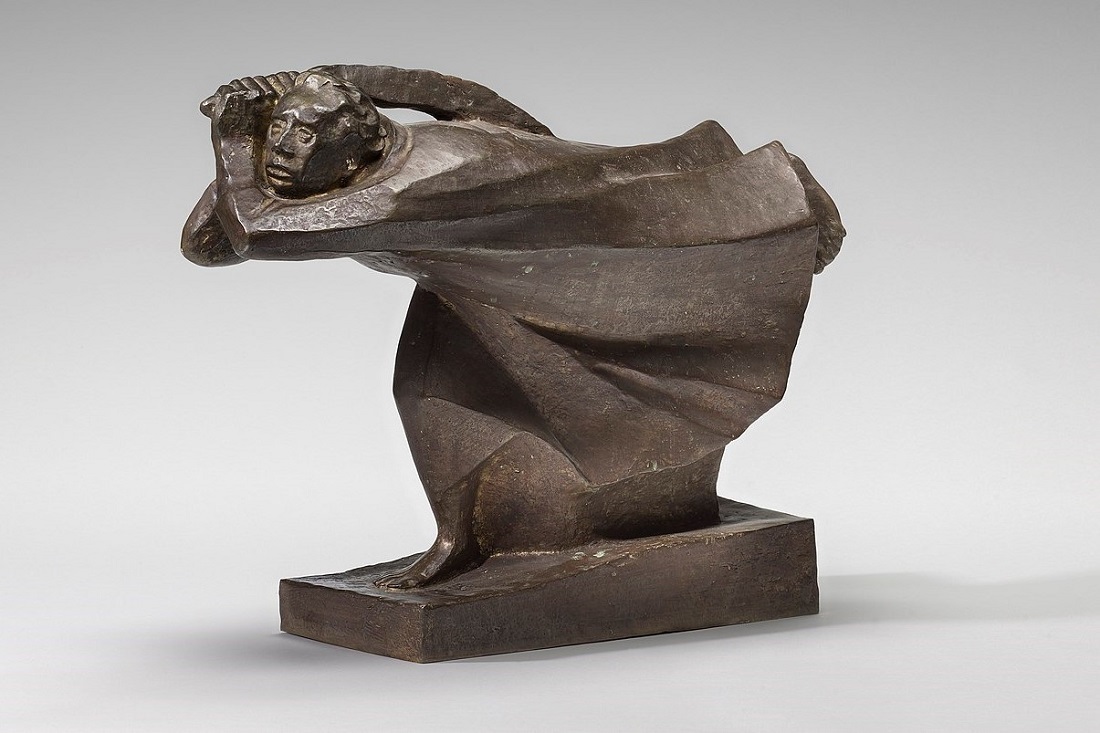In November, when we prayed for the faithful departed, we were also reminded of the reality of our own mortality. When we looked at the empty catafalque present in the sanctuary for All Souls Mass we were reminded that one day we will be a corpse in a coffin while others pray for our soul in the pews. The theme of memento mori ( “remember you will die”) fills this season. I find some of the most poignant reminders of the necessity to live life in light of our imminent death in twentieth-century Canadian author Lucy Maud Montgomery’s fiction: the Anne of Green Gables series and The Blue Castle.
In the eight Anne books, we meet not only the loquacious, awkward, and imaginative orphan, Anne Shirley, but also the minor characters that comprise the little town of Avonlea where she is adopted and grows up. One such character is the golden-haired beauty, Ruby Gillis, who is included in Anne’s set of young friends. Having never had a great deal in common beyond mutual friends and proximity, Anne and the charming Ruby are not, as the orphan protagonist would phrase it, “kindred spirits.” While not malicious and cruel like their unpleasant schoolmate, Josie Pye, Ruby is nonetheless shallow and due to her upbringing and popularity, somewhat vain. After Anne relocates for college the ties that bind the two chums deteriorate. The third book in the series, Anne of the Island, chronicles a visit to Avonlea for summer holidays when Anne is shocked to discover that Ruby is dying of tuberculosis.
While it is clear to everyone in the community that she is gravely ill, Ruby will not acknowledge her condition. Eventually, Ruby confesses to Anne that she is aware of the gravity of her illness but has ignored it because of her fear of death. It’s not that Ruby dreads Hell. In fact, it is quite the opposite. She communicates her confidence that she will reach Heaven explaining, “I am a church member.”[1] But she explains that eternity sounds frightening. “Heaven must be very beautiful, of course, the Bible says so—but, Anne, it won’t be what I’ve been used to.”[2]
Anne reflects, “Heaven could not be what Ruby had been used to. There had been nothing in her gay, frivolous life, her shallow ideals and aspirations, to fit her for that great change or make the life to come seem to her anything but alien and unreal and undesirable.”[3]
How often do we fail to long for Heaven and instead fear that it will be unfamiliar? Do we consider the beatific vision and worry that eternal worship may be boring rather than glorious? If we are living for this world, the next world cannot attract us. If we build our lives around the temporal, the eternal will not be, as poor Ruby explained, what we are used to.
Ruby goes on to say, that dying means “leaving everything I care for,” and Anne realizes her sentiment is:
So horribly true. She was leaving everything she cared for. She had laid up her treasures on earth only; she had lived solely for the little things of life—the things that pass—forgetting the great things that go onward into eternity, bridging the gulf between the two lives and making of death a mere passing from one dwelling to the other--from twilight to unclouded day.[4]
How chilling! To have invested in the temporal only so that when the hour of our death comes, we cling to this life and fear eternity. If we face the reality of memento mori, it is not a question of if we will die, it is merely when: today, tomorrow, a few years from now. We all are dying, and it is living in the light of this truth that can orient us toward Heaven.
Anne Shirley’s suffering as a neglected and abused orphan during her early childhood gives a depth and substance to her character and cultivates a longing for the transcendent that Ruby has never developed in her comfortable life. While Anne’s vibrant (and sometimes morbid) imagination keeps the eternal ever present in her mind, the frivolous and the pleasurable have been Ruby’s whole world.
The Anglican writer C.S. Lewis notes that “We are half-hearted creatures, fooling about with drink and sex and ambition when infinite joy is offered us, like an ignorant child who wants to go on making mud pies in a slum because he cannot imagine what is meant by the offer of a holiday at the sea. We are far too easily pleased.”[5] The unfortunate Ruby has entertained herself with the mudpies of life. She has been too easily pleased. She has not experienced the grief or the deep joy that makes us whole-hearted creatures. And now when she is offered something greater than her small, pleasurable life contains—it, as she says, will not be what she is used to. She has not lived in light of memento mori.
Three years ago, memento mori was present to me as never before. On Ash Wednesday, just before we loaded our children up in our minivan for Mass, I told my husband that I had found a lump in my breast. At higher risk of breast cancer due to family history, I was terrified. But the liturgy of Ash Wednesday, acknowledging that we are formed from the dust and to dust we shall return, was not eerie, but comforting. When we are marked with ashes by the priest, and reminded that we, too, will die, we face the reality of the eternal.
During the weeks I was waiting for doctors’ appointments, referrals, mammograms, and ultrasounds to reveal that all was well, I was admittedly fearful. But living with memento mori at my side woke me up to life. The way my children's eyelashes brushed against their cheeks, the joy of a family dinner savored around the table with the people I loved, the cleansing grace of a good confession, the way the sunlight filtered through the leaves of spring—everything was in vibrant color and full of joy—while losing the last few pounds of baby weight or the siren song of social media were no longer a concern. Only in facing death can we live for things that will not pass away: the eternal souls of men, the worship of God, the holiday at the sea.
The protagonist of L.M. Montgomery’s novel The Blue Castle, Valancy Stirling, experiences this awakening to whole-hearted life when she is pushed into a memento mori perspective with the diagnosis of a terminal heart condition. Having been a diffident child in an overbearing family, she has reached the age of 29 still unmarried, making her quite the spinster according to the cultural norms of early twentieth-century life. She has been so timid and fearful while attempting to please her unpleasant relatives that she sees any small freedoms as an unattainable dream. “The greatest happiness . . . is to sneeze when you want to”[6] she claims. But now with death creeping toward her, possibly descending at any moment with a fatal heart attack, Valancy changes course. She leaves her mother’s oppressive household, pursues real friendships, and proposes to a man her family would consider highly unsuitable. He agrees to marry her (with the knowledge that Valancy will not live long). She learns to love, takes long hikes drinking in the beauty of the natural world, and lives for the first time without fear. The reality of her mortality washes away all that kept her prisoner. She would not have awakened to life if her doctor had not spelled out the reality of her death in the way the priest at an Ash Wednesday Mass marks us with the symbol of death—and our hope for eternal life: the Cross. It is in facing death that we become fully alive.
A dear friend’s father recently passed away after an unexpected diagnosis with a degenerative neurological disease. Having worked decades of overtime in hopes of a luxurious retirement, with a beautiful home bought and retirement almost reached—all those dreams were dashed. His future with decades of life to enjoy the fruits of his labor would never be realized. Death following great suffering and loss of mobility, clear speech, and sight was imminent. My friend, a fellow Catholic convert, put his career on hold to relocate and take care of his father. During these months of agonizing suffering, his father finally asked him to call for a priest to answer some of his questions about faith. That very day he was given the sacraments and was received into the Church. After receiving an apostolic pardon, he died in the arms of his son, my friend. He took his last breath while his son was praying the Hail Mary over him. His illness caused agony for him and his loved ones who watched him suffer such pain. And yet, the reality of the death awaiting him was what oriented him toward eternal life. I can only hope for such a death: being prayed into eternity in the arms of a beloved child as I breathe my last.
My greatest fear in life is that I will be a Ruby Gillis—unprepared for death and fearing it. I should want Heaven with all my soul, but sometimes I, too, am entertained with mud pies, ignoring God’s call to a holiday at the sea. Instead of such a fate, I pray that I will view mortality as St. Francis of Assisi describes death: not as a specter, but as a sister who motivates us to serve God wholeheartedly and to flee from sin that would separate us from him. “Be praised, my Lord, through our Sister Bodily Death, from who see embrace no living person can escape. Woe to those who die in mortal sin! Happy those she finds doing your most holy will. The second death can do no harm to them.”[7]
[1] L. M. Montgomery. Anne of the Island, (New York: Starfire, 1998), 105.
[2] Ibid.
[3] Ibid.
[4] L. M. Montgomery. Anne of the Island, (New York: Starfire, 1998), 106.
[5] C. S. Lewis. The Weight of Glory, (San Francisco: HarperOne, 2001), 26.
[6] L. M. Montgomery. The Blue Castle, (Naperville: SourceBooks Fire, 2014), 66.
[7] St. Francis of Assisi. The Canticle of the Creatures, trans. Bill Barrett.


